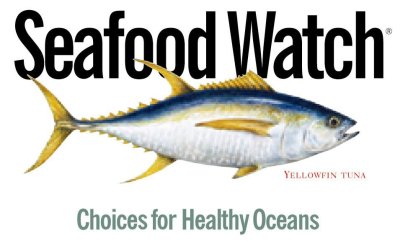It’s a new school year and I’ve made a new blog! (I promise this will be the last time. I’m just sticking to one blog from now on.)
Come and visit!
It’s a new school year and I’ve made a new blog! (I promise this will be the last time. I’m just sticking to one blog from now on.)
Come and visit!
Posted in Class info
Your homework reading came from a website for the Seafood Watch, which is a program from the Monterey Bay Aquarium that is designed to raise consumer awareness about the importance of buying seafood from sustainable sources.
Please check out the site. Download their Regional guide and their Sushi guide for environmentally responsible seafood eating. If you don’t like seafood, no problem! Pass on the information to others.
For your homework, you will look at the Seafood Guide link here.

Posted in Homework, Marine Biology
We had a great time at the museum!
I had meant to show this before we went but here it is anyway. A brief video about creating the coral reef:
And here’s the one showing a sea cucumber do its thing:
Posted in Marine Biology
1) Read “What are vertebrates?”
2) Complete HW#30: Ask the Fish
Block I: Wednesday, May 20
Block II: Friday, May 22
Block III: next Tuesday, May 26 (You will have block class on Tuesday because Monday is a holiday.)
***********************************************************************
1) Read “What’s troubling our waters?”
2) Complete HW#31: Leftover Salmon
Due date:
Block I: next Wed., May 27
Block II: next Friday, May 29
Block III: next Thursday, May 28
***********************************************************************
This week’s homework is all inspired by the band, Leftover Salmon. This band is from Colorado and they describe themselves as “Polyethnic Cajun Slamgrass.” I started listening to them in high school. They are a crazy fun band to see and dance to.
Here’s some tracks:
Posted in Homework, Musical Notes
Posted in Marine Biology
MARINE BIOLOGY TEST DATES:
Block I: Wednesday, May 13
Block II: Friday, May 15
Block III: next Monday, May 18
********************************************************************
1) Complete Study Guide
2) Write 3 questions/answers on the wiki
Due date:
Block I: Monday, May 11
Block II: Tuesday, May 12
Block III: Thursday, May 14
********************************************
STUDY FOR THE TEST!
*Use flashcards, make up your own questions, use the study guide on the wiki, concentrate on the concepts that are difficult for you, play jeopardy, and make sure you have all of the readings!
Posted in Homework, Uncategorized
Gastropods!
Snails, slugs, and nudibranchs!
Abalone, whelks, and limpets!

Shells of various marine gastropods

Family Olividae

Family Muricidae- This gastropod has its operculum closed.

Family Conidae-These snails hunt and immobilize their prey by using a modified radula that is launched out like a harpoon along with a poison gland.

Family Haliotidae-Abalone do not have an operculum. The inside of an abalone shell is iridescent and quite beautiful.
A video about nudibranchs!
Posted in Marine Biology
Cephalopods are so awesome!!
Pictures do not do them any justice.
Here are videos to see them in action:
This one is in Spanish but I think you guys can figure it out. Octopuses are amazing!
Dramatic footage of Cuttlefish:
Vampryrotheuthis (The Vampire Squid from Hell)
Posted in Marine Biology
**We’re going to the Academy of Sciences on Thursday!!!!!*****
1) Read “Echinoderms”
2) Complete HW#29: Gone Under Sea
Due Date:
Block I: Wednesday
Block II: Friday
Block III: next Monday, May 11
***********************************************************************
3) Complete Marine Biology Study Guide
4) Add your questions/ answers to the class wiki. Instructions are in the Study guide. Please let me know if you have any trouble logging in. You can leave a comment here.
Due date:
Block I: next Monday, May 11
Block II: next Tuesday, May 12
Block III: next Thursday, May 14
***********************************************************************
Musical Notes:
“Gone Under Sea” is a song by the British band, Electrelane. I would describe them as an experimental blend of Stereolab/My Bloody Valentine/Velvet Underground with a splash of Andy Warhol.
Here’s the song:
Posted in Homework, Marine Biology, Musical Notes
Bivalves are molluscs that have two shells attached at a hinge. Unlike other molluscs, they do not have a radula. They siphon and filter food particles from the water. Some bivalves attach themselves to a surface, while others burrow in sand or sediment. Some bivalves, like scallop, clap their shells together and swim!
Here are some examples from this class:

Here's Tridacna derasa, the smooth giant clam or southern giant clam. The spherical items on the right hand side of its shell are sea squirts, enjoying a free ride! The sea squirts aren't contributing anything to the clam (except, perhaps, making it more photogenic), but the clams do live in a symbiotic relationship with algae, just as coral do, but in a more sophisticated way. The giant clam has a system of channels which branches out to all parts of its mantle, and the algae live in these channels. The clam can discard old algae if there are too many or if overheated, or retain all of them if it needs more.

California mussel (Mytilus californianus)- These mussels are attached to the rock with byssal threads.
And here’s the fabulous swimming scallop in action:
Class dissections!
Posted in Marine Biology